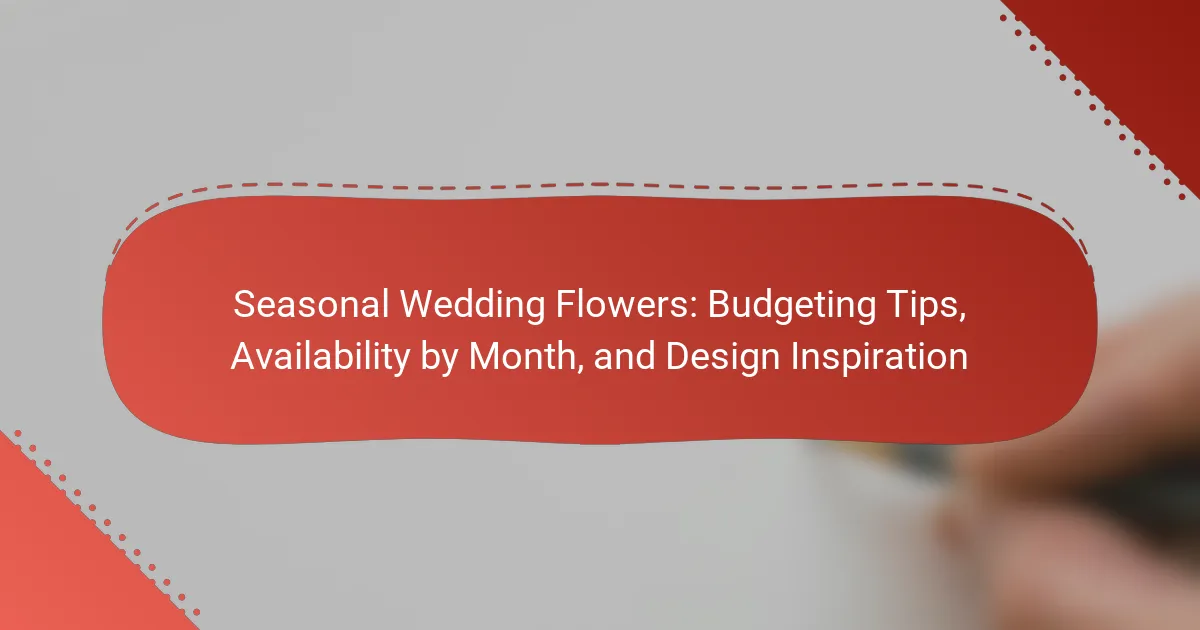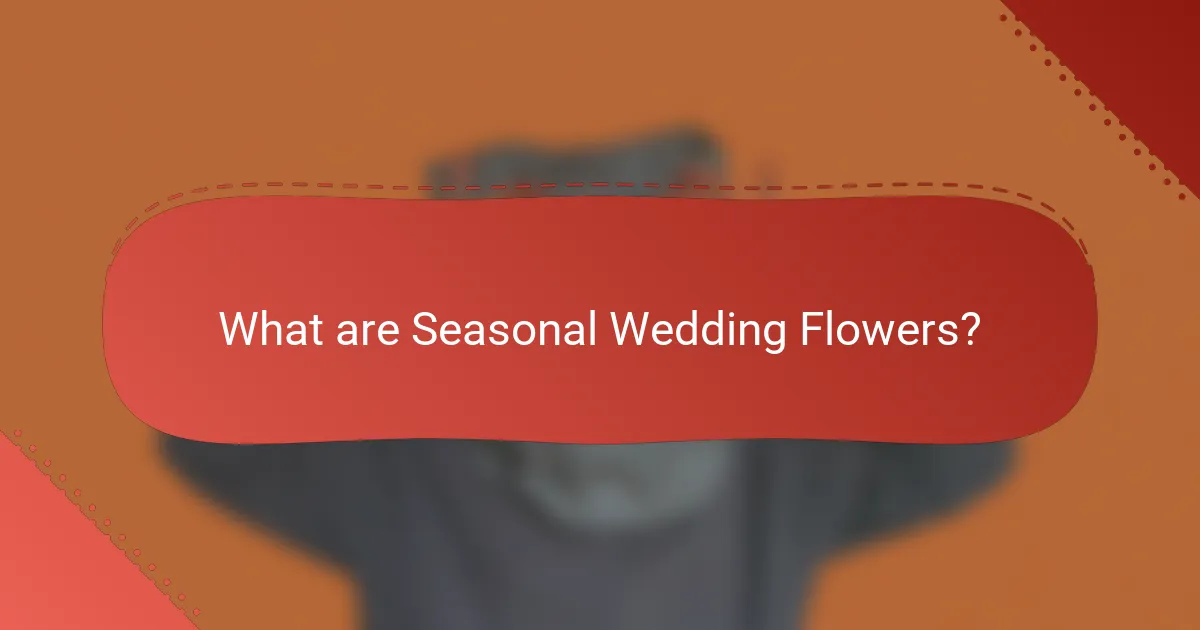
What are Seasonal Wedding Flowers?
Seasonal wedding flowers are blooms that are available during specific times of the year. They vary based on climate and region. For example, peonies are typically in season during late spring. In contrast, dahlias are more common in late summer and fall. Using seasonal flowers can reduce costs due to their abundance. Additionally, they often have better quality and freshness. Choosing flowers in season can enhance the overall aesthetic of a wedding. This practice aligns with sustainable floral design by minimizing transportation.
Why choose seasonal flowers for weddings?
Seasonal flowers are ideal for weddings due to their freshness and availability. Using flowers in season ensures vibrant colors and optimal quality. They are often more affordable than out-of-season varieties. Seasonal flowers are also more sustainable, reducing environmental impact. Local sourcing is easier with seasonal blooms, supporting local growers. Additionally, they can enhance the wedding’s overall theme by reflecting the season’s natural beauty. Studies show that seasonal flowers can reduce costs by up to 30%. Choosing seasonal flowers creates a cohesive and harmonious aesthetic for the wedding.
What advantages do seasonal flowers offer for wedding budgets?
Seasonal flowers offer significant advantages for wedding budgets by reducing costs. They are more readily available during their peak seasons, which lowers transportation and sourcing expenses. Local suppliers often provide seasonal blooms at competitive prices due to lower shipping costs. Additionally, using seasonal flowers allows couples to take advantage of bulk purchasing discounts. Many florists recommend seasonal options, which can lead to cost-effective arrangements. Research shows that couples can save up to 20-30% on floral expenses by choosing in-season varieties. This approach not only enhances budget efficiency but also supports local agriculture.
How do seasonal flowers contribute to wedding aesthetics?
Seasonal flowers enhance wedding aesthetics by providing natural beauty and vibrant colors. They align with the wedding’s theme and season, creating a cohesive look. Seasonal blooms are often fresher and more fragrant, enhancing the overall sensory experience. Their availability can also reduce costs, as they do not require extensive shipping. Flowers like peonies in spring or sunflowers in summer evoke specific emotions and atmospheres. This choice can influence the mood of the event, making it feel more intimate or festive. Using seasonal flowers showcases a couple’s connection to nature and their chosen time of year.
How do seasonal flowers vary by region?
Seasonal flowers vary significantly by region due to climate differences. In temperate regions, spring brings tulips and daffodils. Summer features sunflowers and roses. Fall showcases chrysanthemums and asters. Winter often has poinsettias and holly. In tropical areas, seasonal flowers include hibiscus and bougainvillea year-round. These variations are influenced by local temperatures, rainfall, and growing seasons. For example, California’s Mediterranean climate supports a wide range of blooms throughout the year. Conversely, colder regions have a shorter growing season, limiting flower availability. This regional diversity affects wedding flower choices and budgeting.
Which flowers are considered seasonal in different climates?
Seasonal flowers vary significantly based on climate. In temperate climates, popular seasonal flowers include tulips in spring and chrysanthemums in fall. Tropical climates see seasonal blooms like hibiscus and plumeria year-round. In arid regions, succulents and desert wildflowers thrive during the rainy season. Each flower’s availability aligns with local weather patterns and growing conditions. Seasonal flowers enhance wedding aesthetics and can influence budgeting. Understanding local seasons helps in selecting the right flowers for events.
How does location influence flower availability?
Location significantly influences flower availability due to climate, growing conditions, and regional agriculture. Different regions have varying climates that affect which flowers can thrive. For instance, warmer climates can support a wider variety of blooms year-round. In contrast, colder regions may have limited flower types available during winter months. Additionally, local agriculture practices dictate the types of flowers that are cultivated. Regions known for specific flowers, such as California for roses, will have a higher availability of those varieties. Seasonal changes also impact flower availability, as certain species bloom at specific times of the year. Therefore, understanding the local environment is crucial for determining which flowers are accessible for events like weddings.
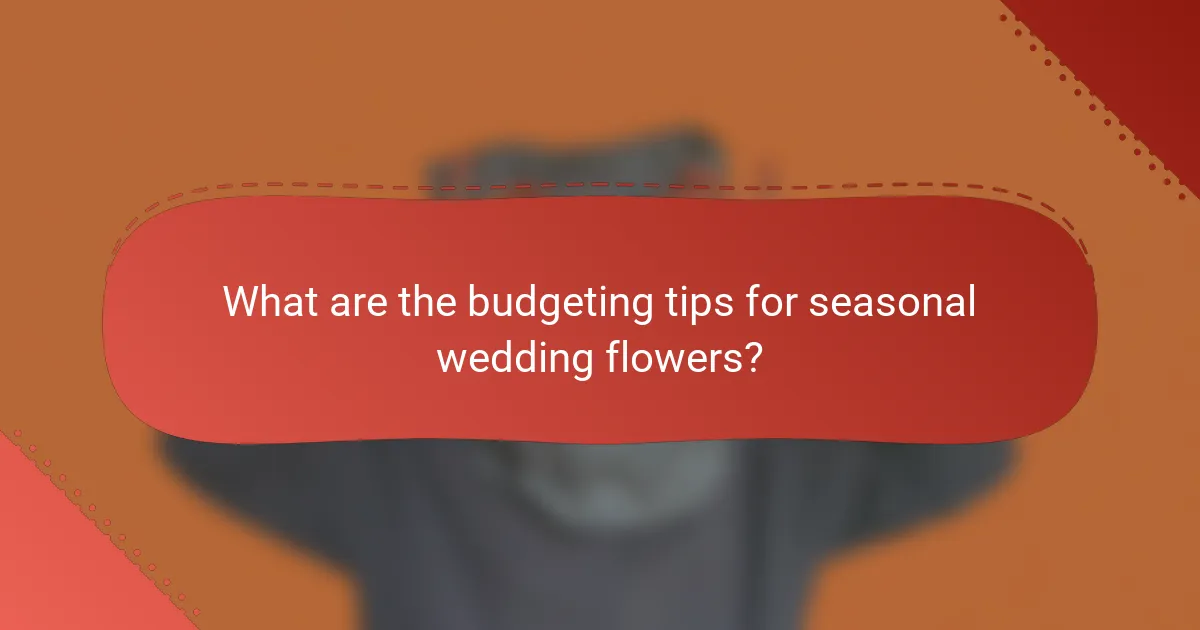
What are the budgeting tips for seasonal wedding flowers?
Choose seasonal flowers to reduce costs. Seasonal flowers are often more affordable due to their availability. Research local flower markets for better pricing. Compare prices between different vendors to find the best deals. Consider using fewer expensive flowers and supplementing with greenery. Greenery is generally less costly and adds volume. Plan arrangements that utilize bulk flowers for savings. Bulk purchases can significantly cut down expenses. Set a clear budget and stick to it. This ensures you do not overspend on floral arrangements.
How can couples effectively budget for seasonal flowers?
Couples can effectively budget for seasonal flowers by researching local flower availability and prices. Understanding which flowers are in season helps identify cost-effective options. For example, seasonal flowers like peonies in spring or sunflowers in summer are typically more affordable. Couples should also set a clear budget limit for floral arrangements. Allocating specific amounts for bouquets, centerpieces, and decor ensures a comprehensive financial plan. Additionally, comparing prices from multiple florists can lead to better deals. Utilizing online resources or local markets may provide further savings. Finally, couples can consider DIY arrangements using seasonal blooms to reduce costs significantly.
What are the average costs of seasonal flowers by month?
The average costs of seasonal flowers vary by month. In January, the average cost is around $50 per bouquet. February sees a rise to approximately $60 due to Valentine’s Day demand. March averages $45 as spring flowers begin to emerge. April costs about $55 as more varieties become available. May is higher at around $75, coinciding with wedding season. June averages $70, maintaining high demand. July drops to about $50 as summer blooms peak. August costs around $55, with late summer flowers in abundance. September averages $60 as fall flowers start appearing. October sees an increase to about $65, with autumn themes prevalent. November costs around $50 as the season quiets. December averages $70 due to holiday floral arrangements.
How can DIY arrangements help save money on seasonal flowers?
DIY arrangements help save money on seasonal flowers by eliminating labor costs associated with professional florists. By sourcing flowers directly from local markets or farms, individuals can purchase blooms at a lower price. Additionally, creating arrangements at home allows for customization and control over the quantity of flowers used. This can significantly reduce waste and ensure that only necessary materials are purchased. Studies indicate that DIY floral arrangements can cut costs by up to 50% compared to hiring a florist. Overall, the combination of direct purchasing and personal labor leads to substantial savings.
What are some strategies for maximizing flower budgets?
To maximize flower budgets, consider using seasonal flowers. Seasonal flowers are typically more affordable and readily available. They reduce transportation costs and support local growers. Another strategy is to choose larger blooms. Larger blooms can create a significant impact with fewer stems. This approach minimizes the number of flowers needed for arrangements. Additionally, utilizing greenery can enhance arrangements without adding significant costs. Greenery fills space and adds texture.
Buying in bulk is another effective strategy. Bulk purchases often come with discounts, reducing overall expenses. Planning arrangements around the wedding date can also help. Early planning allows for price comparisons and securing the best deals. Finally, DIY arrangements can significantly cut costs. Creating your own floral designs can save on labor expenses. Implementing these strategies can lead to substantial savings on flower budgets.
How can choosing local flowers reduce costs?
Choosing local flowers can significantly reduce costs due to lower transportation expenses. Local flowers require less shipping, which decreases overall pricing. Additionally, local growers often sell directly to consumers, eliminating middleman costs. This direct sale reduces markups typically associated with floral arrangements. Furthermore, seasonal local flowers are often more abundant, leading to competitive pricing. According to a study by the American Society of Floral Designers, using locally sourced flowers can save up to 30% on floral budgets. Overall, opting for local flowers supports the economy while providing cost-effective options for weddings.
What are the benefits of purchasing in bulk for seasonal flowers?
Purchasing seasonal flowers in bulk offers significant cost savings. Bulk purchases typically reduce the price per stem, allowing for a larger quantity within a budget. This approach also ensures better availability of specific seasonal varieties. Florists often prioritize bulk orders, resulting in fresher flowers and improved quality. Additionally, buying in bulk minimizes the need for frequent restocking, saving time and effort. Research indicates that bulk buying can lead to up to a 30% reduction in costs compared to individual purchases. Overall, bulk purchasing is a strategic choice for maximizing value and quality in seasonal flower arrangements.
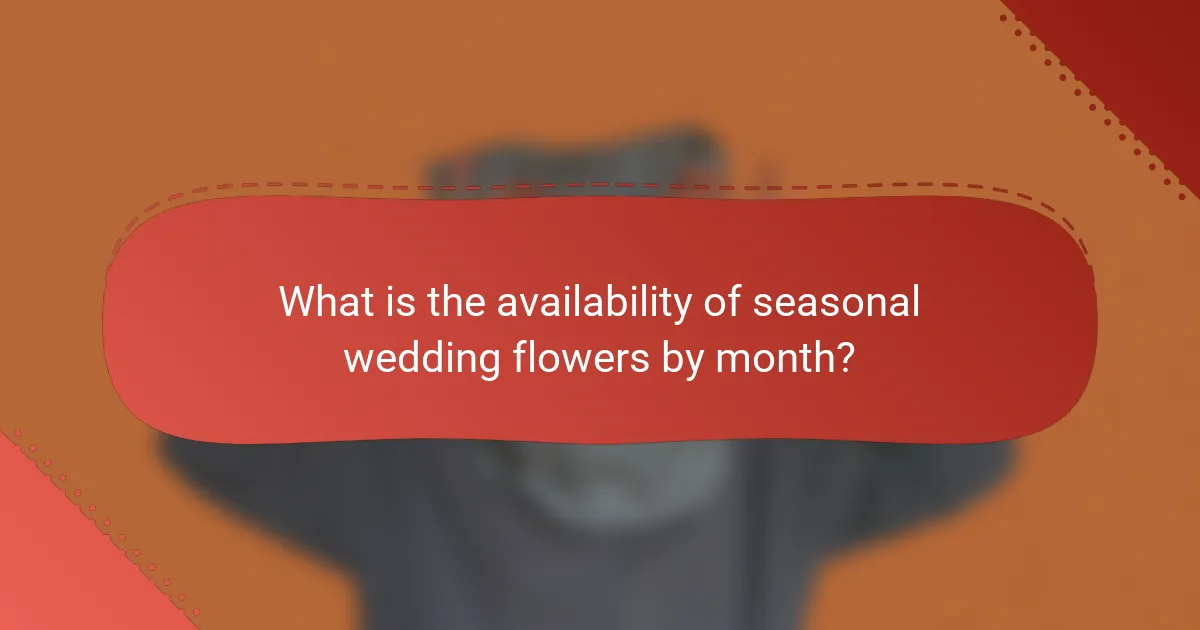
What is the availability of seasonal wedding flowers by month?
January: Available flowers include tulips, amaryllis, and winter jasmine.
February: Common flowers are roses, tulips, and calla lilies.
March: Spring blooms like daffodils, hyacinths, and anemones become available.
April: Seasonal flowers include peonies, lilacs, and cherry blossoms.
May: Popular choices are peonies, lilies of the valley, and garden roses.
June: Available flowers feature roses, peonies, and sweet peas.
July: Seasonal blooms include sunflowers, dahlias, and zinnias.
August: Common flowers are gladiolus, lilies, and hydrangeas.
September: Available flowers include asters, chrysanthemums, and dahlias.
October: Seasonal blooms feature marigolds, cosmos, and zinnias.
November: Available flowers are chrysanthemums, roses, and calla lilies.
December: Common choices include poinsettias, amaryllis, and evergreen foliage.
Which flowers are in season during each month?
January: Carnations, snowdrops, and hellebores are in season. February: Tulips, daffodils, and hyacinths bloom. March: Daffodils, tulips, and ranunculus appear. April: Lilies, peonies, and sweet peas are available. May: Peonies, roses, and irises flourish. June: Roses, peonies, and hydrangeas are abundant. July: Sunflowers, dahlias, and zinnias thrive. August: Gladiolus, dahlias, and sunflowers continue. September: Asters, chrysanthemums, and zinnias are in season. October: Marigolds, chrysanthemums, and asters bloom. November: Chrysanthemums, pansies, and roses are available. December: Poinsettias, holly, and evergreens are in season.
What are the most popular flowers for each month?
January: Carnations are popular for January weddings. They symbolize admiration and love.
February: Roses dominate February, especially for Valentine’s Day. They represent love and passion.
March: Daffodils are favored in March. They signify new beginnings and hope.
April: Tulips are popular in April. They symbolize elegance and grace.
May: Peonies are a top choice in May. They represent prosperity and good fortune.
June: Roses are again popular in June. They are often associated with romance.
July: Sunflowers shine in July. They symbolize adoration and loyalty.
August: Dahlias are favored in August. They represent dignity and elegance.
September: Asters are popular in September. They symbolize love and wisdom.
October: Marigolds are favored in October. They represent warmth and creativity.
November: Chrysanthemums are popular in November. They symbolize optimism and joy.
December: Poinsettias are favored in December. They represent celebration and joy.
How do holidays and events affect flower availability?
Holidays and events significantly affect flower availability. Demand for specific flowers increases during major holidays like Valentine’s Day and Mother’s Day. This heightened demand can lead to shortages of popular varieties. Events such as weddings also drive demand, particularly for seasonal blooms. Florists may struggle to meet the needs of customers during peak times. Additionally, supply chain disruptions can occur due to increased orders. Seasonal variations further influence what flowers are available. For instance, certain flowers may only be in season during specific months.
How can couples plan their flower choices based on monthly availability?
Couples can plan their flower choices by researching which flowers are in season each month. Seasonal flowers are typically more affordable and fresher. For example, peonies are abundant in May, while sunflowers thrive in July. Knowing the monthly availability helps couples align their flower choices with their wedding date. This approach ensures vibrant blooms that match the season’s aesthetics. Additionally, local florists often provide guidance on seasonal options. Couples can also consider regional variations in flower availability. This knowledge enhances their overall wedding planning experience.
What resources can help track seasonal flower availability?
Online databases and websites can help track seasonal flower availability. Resources like the American Society of Florists provide regional flower availability charts. Local farmers’ markets often list seasonal flowers available in your area. Additionally, floral supply companies publish seasonal guides for wedding flowers. Mobile apps for gardening and floristry also offer real-time updates on flower seasons. These resources ensure accurate tracking of flower availability throughout the year.
How can seasonal flower charts assist in wedding planning?
Seasonal flower charts assist in wedding planning by providing information on flower availability throughout the year. These charts help couples choose blooms that are in season, ensuring freshness and cost-effectiveness. For example, peonies are typically available in late spring, while sunflowers are best in summer. By using these charts, couples can avoid expensive imports and select locally sourced flowers. This approach not only supports local florists but also enhances the wedding’s aesthetic with seasonal themes. Additionally, seasonal flowers often align better with the wedding’s overall design and color palette. Thus, seasonal flower charts are essential tools for effective wedding planning.
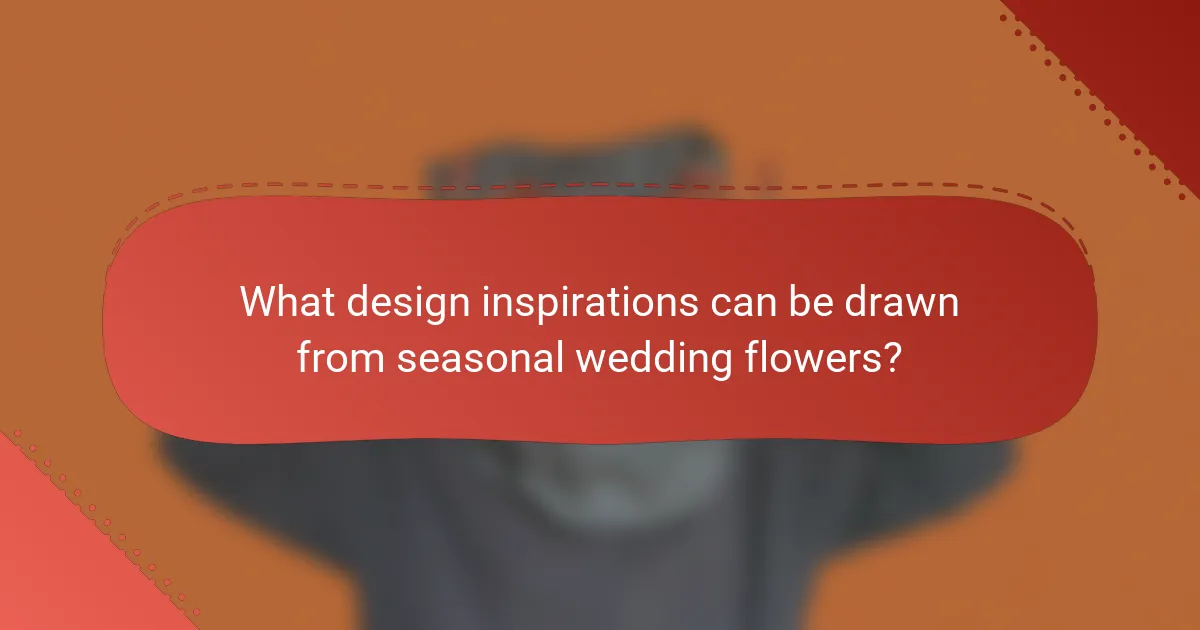
What design inspirations can be drawn from seasonal wedding flowers?
Seasonal wedding flowers provide varied design inspirations based on their colors, shapes, and availability. For example, spring flowers like peonies and tulips offer soft pastels, creating a romantic palette. Summer blooms such as sunflowers and dahlias introduce vibrant hues, perfect for bold designs. Autumn flowers like chrysanthemums and dahlias can add rich, warm tones, evoking a cozy atmosphere. Winter florals, including evergreens and amaryllis, bring a festive touch with deep reds and greens. Each season’s unique flowers can influence overall wedding themes, from rustic to elegant. Incorporating seasonal flowers ensures freshness and can align with the couple’s chosen color scheme.
How can seasonal flowers enhance wedding themes?
Seasonal flowers enhance wedding themes by providing natural beauty that aligns with the time of year. They offer unique colors and fragrances that reflect seasonal changes. For example, spring weddings can feature tulips and daffodils, while autumn weddings can incorporate chrysanthemums and dahlias. Using seasonal flowers can also reduce costs, as these blooms are more readily available. Fresh, in-season flowers are often more vibrant and healthier than out-of-season options. This choice can create a cohesive aesthetic that ties the wedding decor to the season. Additionally, seasonal flowers can evoke specific emotions and themes associated with different times of the year, enhancing the overall experience for guests.
What are some popular wedding themes that utilize seasonal flowers?
Popular wedding themes that utilize seasonal flowers include rustic, garden, and beach themes. Rustic themes often feature wildflowers and greenery, reflecting a natural, outdoor setting. Garden themes emphasize blooms like peonies and roses, creating a romantic atmosphere. Beach themes incorporate tropical flowers such as hibiscus and orchids, enhancing a coastal vibe. Each theme aligns with seasonal availability, ensuring fresh and vibrant floral arrangements.
How can color palettes be influenced by seasonal flower choices?
Color palettes can be significantly influenced by seasonal flower choices. Different seasons provide distinct flowers with unique colors. For example, spring offers pastel blooms like tulips and daisies. These colors can create a soft and romantic palette. Summer brings vibrant flowers like sunflowers and dahlias, leading to bold and bright color schemes. Autumn features warm tones from chrysanthemums and dahlias, inspiring earthy palettes. Winter flowers, such as poinsettias and evergreens, can evoke cool and festive colors. The availability of these flowers can dictate the overall aesthetic of floral arrangements. Seasonal flowers help ensure that color palettes align with the natural beauty of the time of year.
What are some creative ways to incorporate seasonal flowers into wedding decor?
Seasonal flowers can be creatively incorporated into wedding decor in various ways. First, use them as centerpieces on tables. This adds color and elegance to the dining experience. Second, create floral garlands for draping along tables or arches. Garlands can enhance the overall aesthetic and bring a natural feel to the venue. Third, utilize seasonal blooms in bridal and bridesmaid bouquets. This personalizes the wedding and ties the theme together. Fourth, incorporate flowers into the wedding cake design. Edible flowers or floral decorations can elevate the cake’s visual appeal. Fifth, use flowers in hair accessories for the bridal party. This adds a cohesive floral touch to the overall look. Lastly, consider floral installations as focal points. Large arrangements can serve as stunning backdrops for photos. Each of these methods effectively showcases seasonal flowers while enhancing the wedding decor.
How can seasonal flowers be used in bouquets and centerpieces?
Seasonal flowers can be used in bouquets and centerpieces to enhance aesthetic appeal and reduce costs. These flowers are readily available during specific times of the year, ensuring freshness. For instance, peonies are popular in spring, while sunflowers thrive in summer. Using seasonal flowers allows for vibrant color palettes that match the wedding theme. Additionally, they tend to be more affordable due to lower transportation costs. Incorporating locally sourced seasonal flowers supports local growers and promotes sustainability. Seasonal arrangements can also reflect the natural beauty of the season, adding a unique touch to the decor.
What unique arrangements can be created with seasonal flowers?
Unique arrangements with seasonal flowers include seasonal bouquets, centerpieces, and wreaths. Seasonal bouquets can feature flowers that bloom during specific months, enhancing the theme of the event. Centerpieces can incorporate local and in-season blooms, providing freshness and vibrancy. Wreaths made from seasonal flowers can adorn doors or tables, reflecting the natural beauty of the season. Additionally, flower crowns can be crafted from seasonal blooms, adding a unique touch to weddings. These arrangements not only celebrate the season but also support local florists and reduce costs. Using seasonal flowers ensures the arrangement is fresh and in harmony with the environment.
What practical tips should couples consider when choosing seasonal wedding flowers?
Couples should consider the availability of flowers in their wedding season. Research local florists to identify what blooms are in season. Seasonal flowers tend to be more affordable than out-of-season options. They also last longer and look fresher. Consider the color palette of the wedding when selecting flowers. This helps create a cohesive design. Think about the overall theme and style of the wedding. Choose flowers that complement the venue and decor. Lastly, consult with a florist to explore unique seasonal varieties. This can add a personal touch to the wedding arrangements.
Seasonal wedding flowers are blooms available during specific times of the year, varying by climate and region. This article provides insights into the benefits of choosing seasonal flowers for weddings, including cost savings, enhanced aesthetics, and sustainability. It outlines budgeting tips, monthly availability, and popular flower choices, as well as design inspirations that align with seasonal themes. Additionally, it discusses how location influences flower availability and offers practical tips for couples to effectively select and incorporate seasonal flowers into their wedding decor.
